
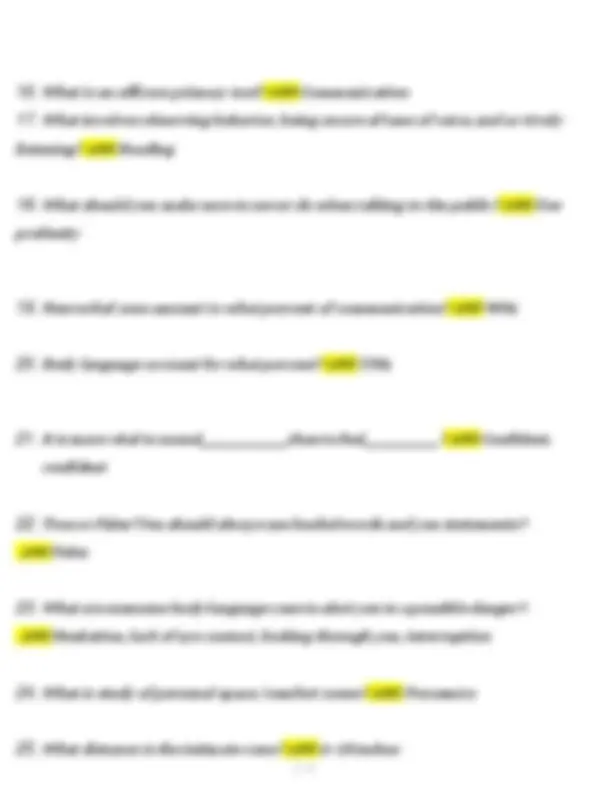
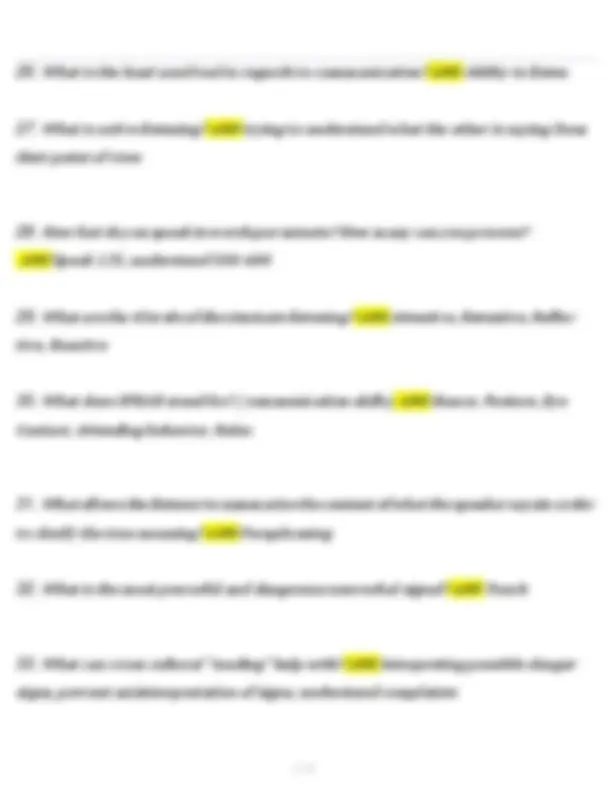
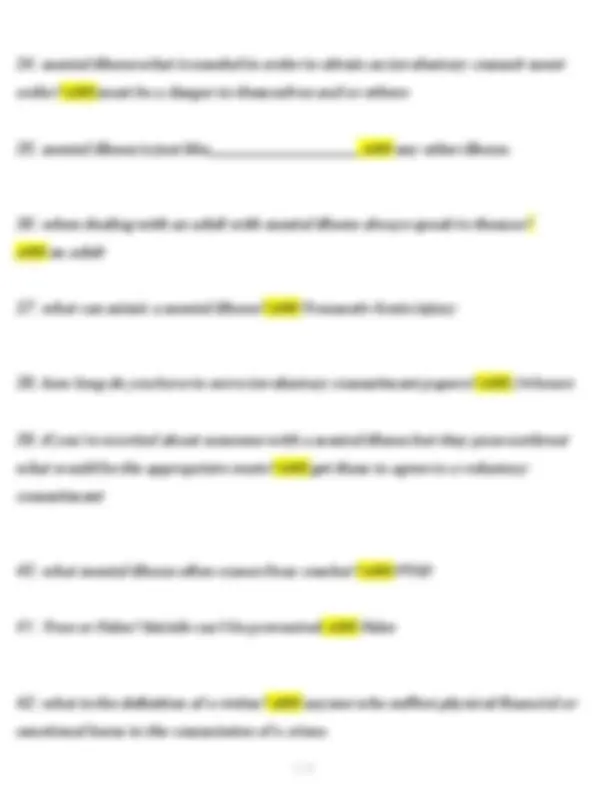
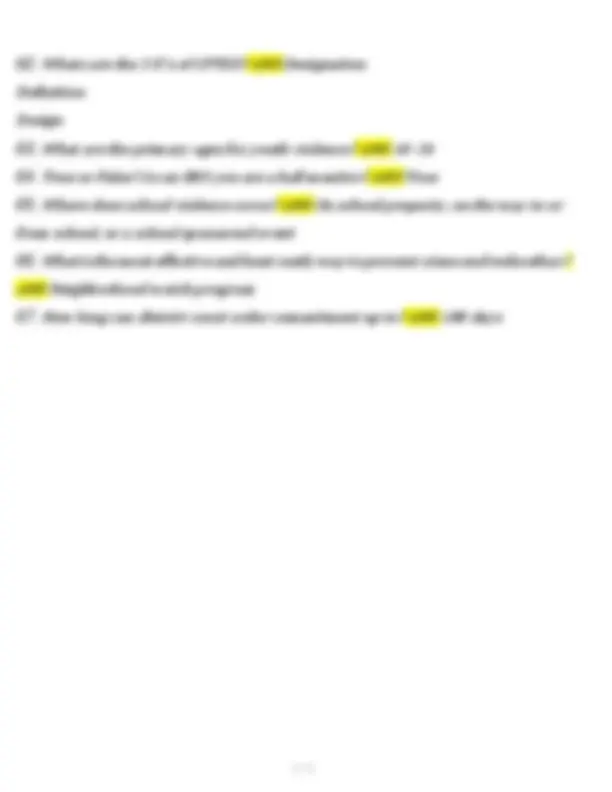
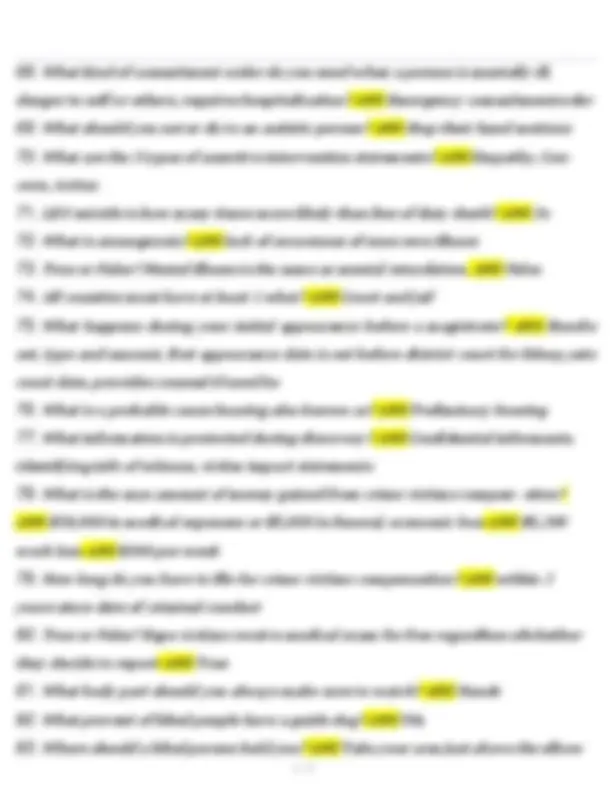
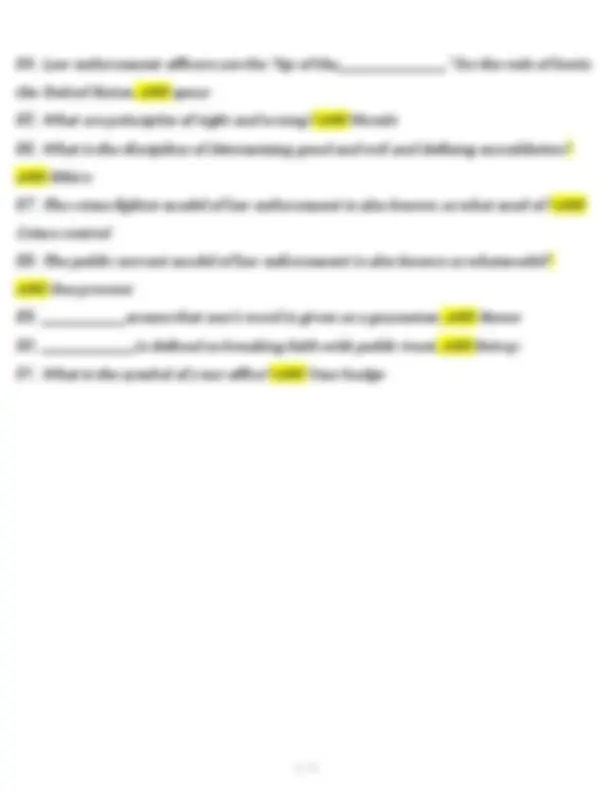
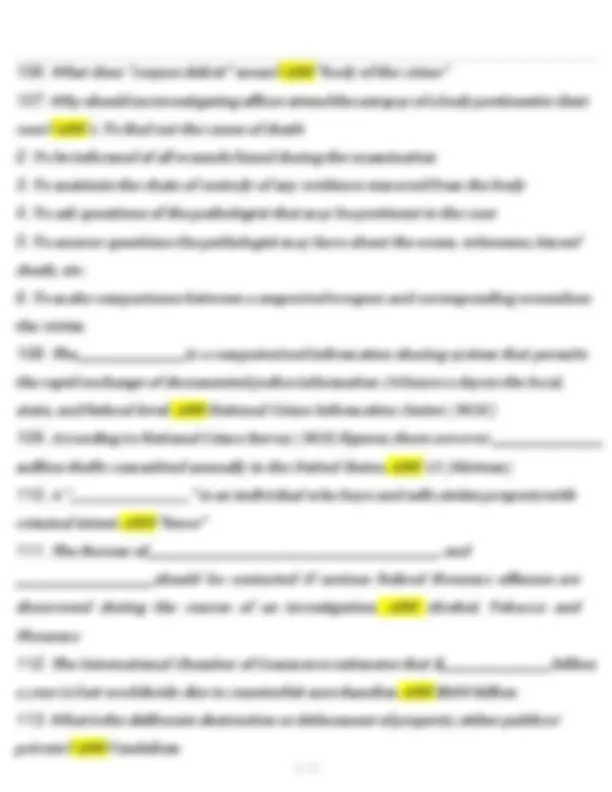
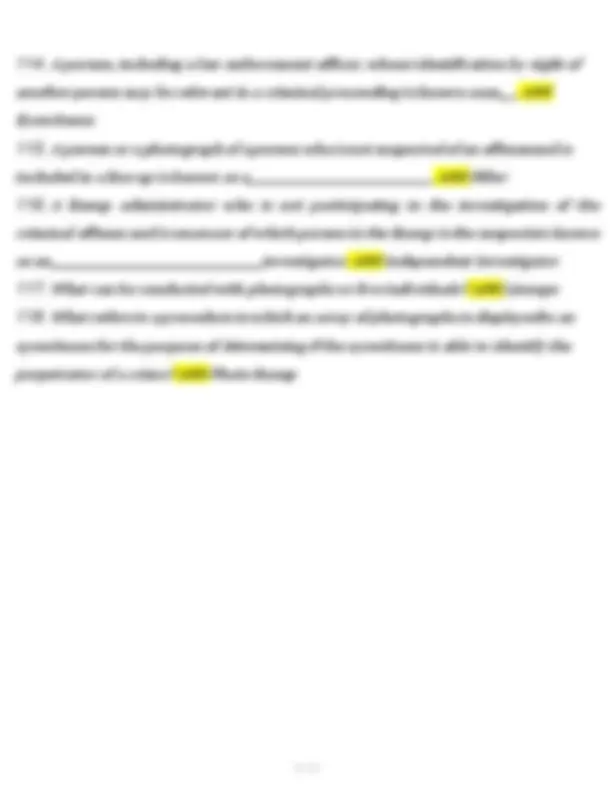
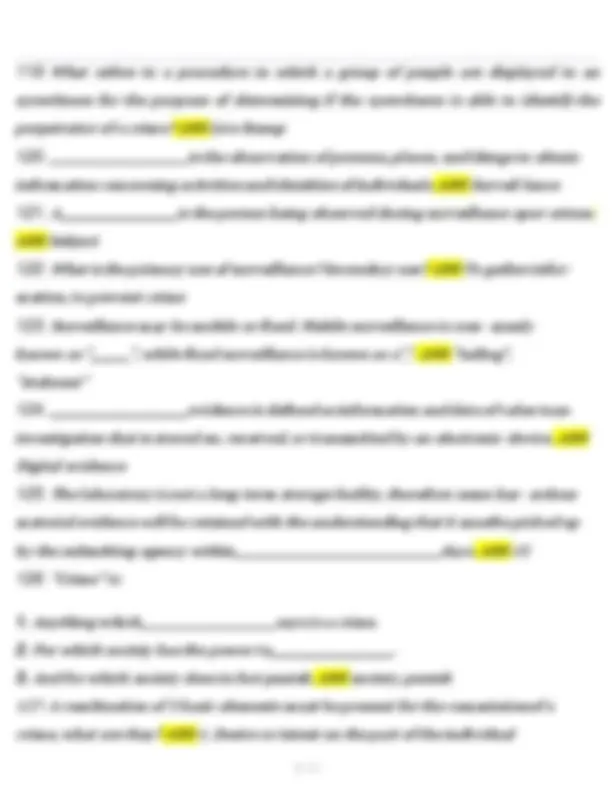
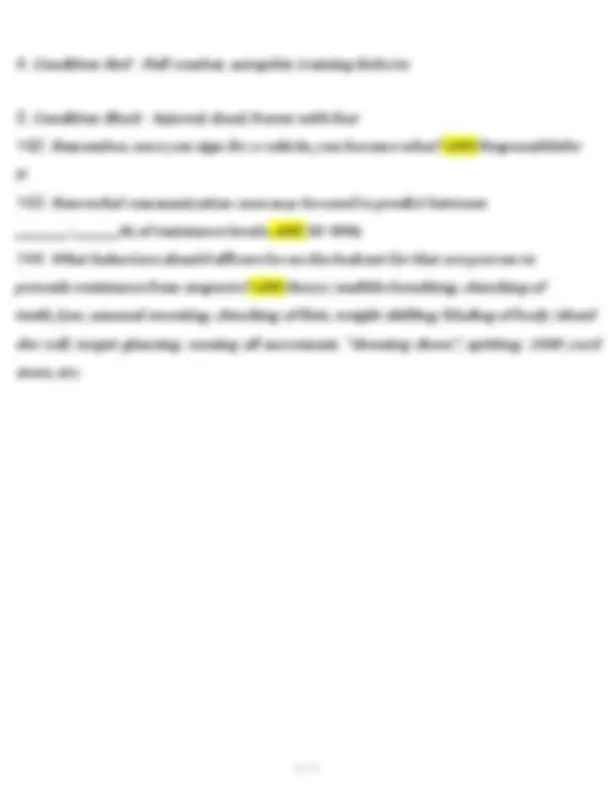

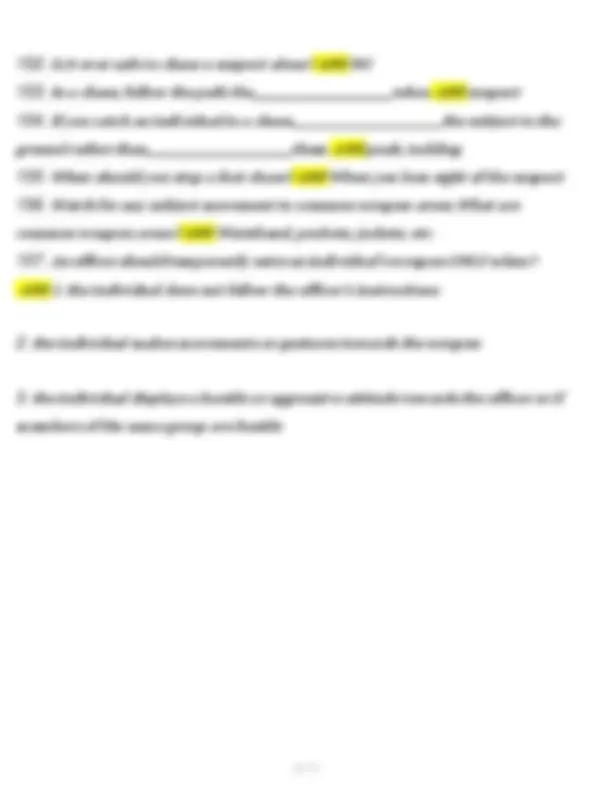
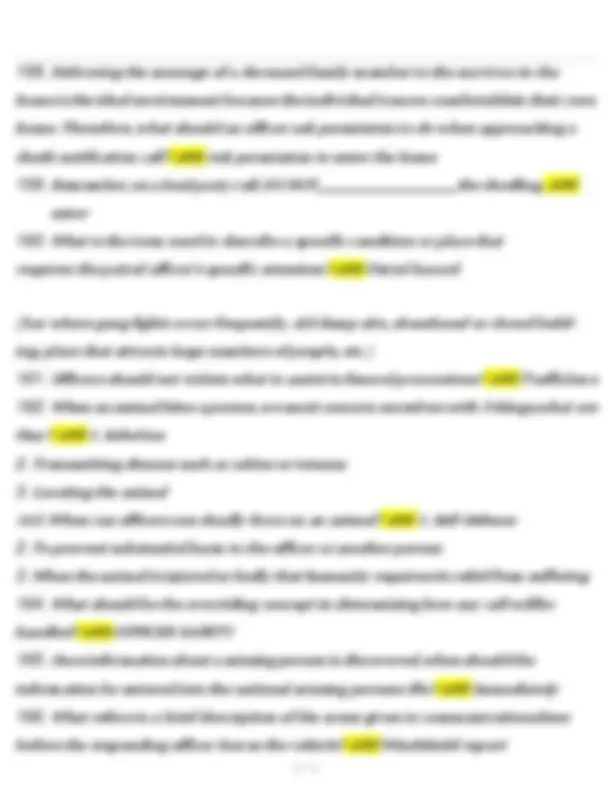
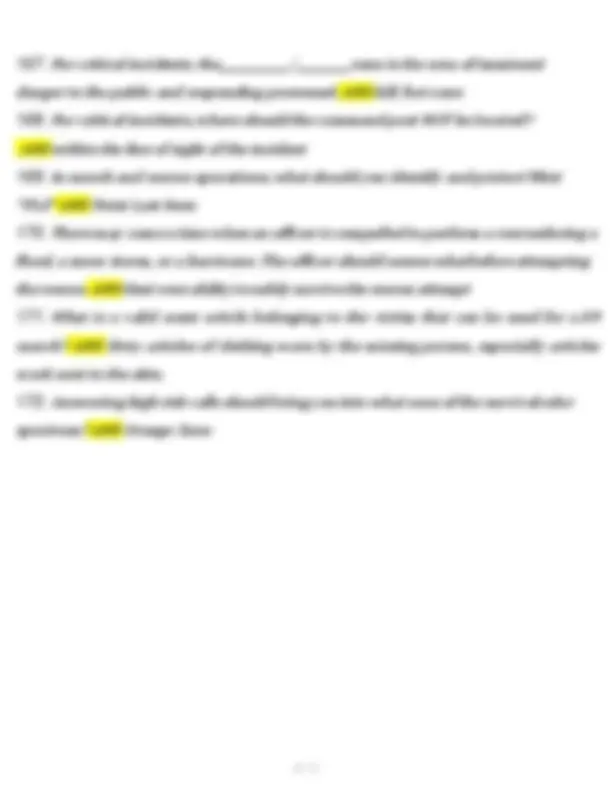
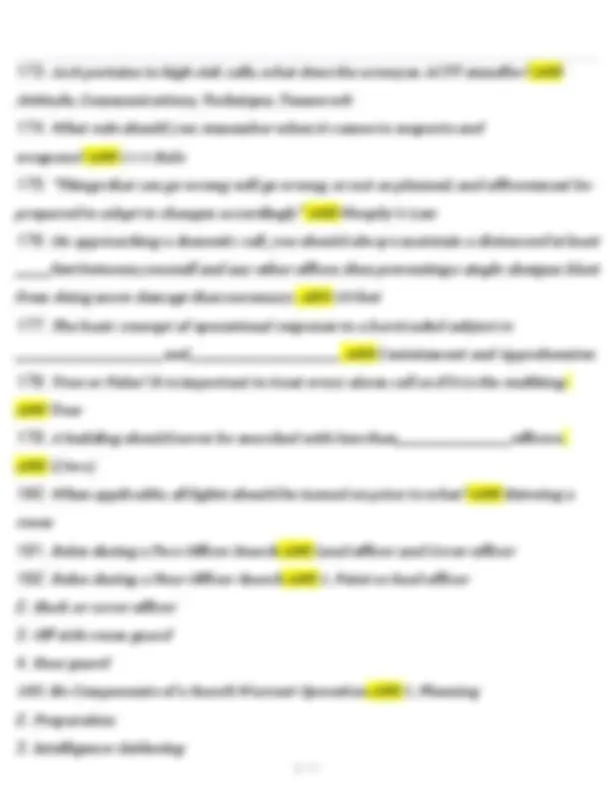
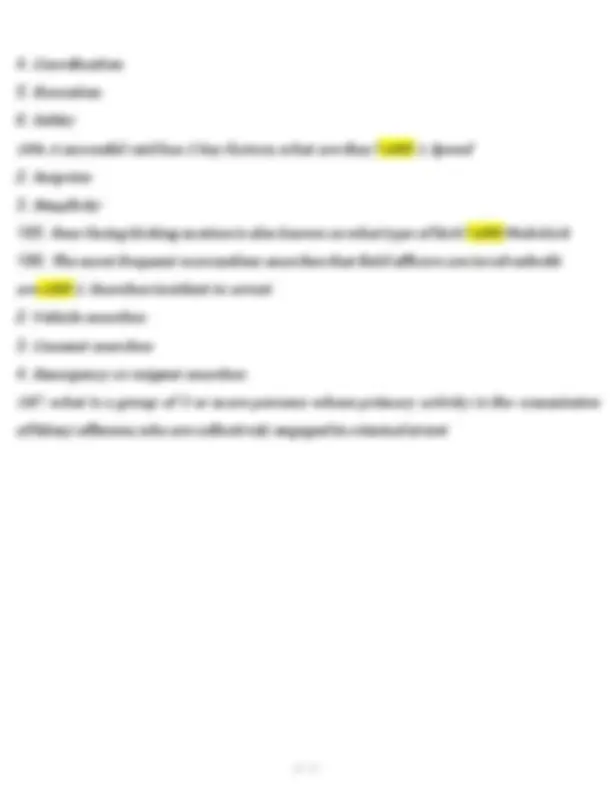



Study with the several resources on Docsity

Earn points by helping other students or get them with a premium plan


Prepare for your exams
Study with the several resources on Docsity

Earn points to download
Earn points by helping other students or get them with a premium plan
Community
Ask the community for help and clear up your study doubts
Discover the best universities in your country according to Docsity users
Free resources
Download our free guides on studying techniques, anxiety management strategies, and thesis advice from Docsity tutors
This study guide covers key concepts and information related to law enforcement communication, including domestic violence, mental illness, crime prevention, and ethical conduct. It provides a series of questions and answers that can be used for studying for the nc blet state exam. The guide emphasizes the importance of effective communication skills, understanding mental health issues, and ethical decision-making in law enforcement.
Typology: Exams
1 / 25

This page cannot be seen from the preview
Don't miss anything!


















1. How many times will a victim leave on average in a domestic violence relationship? ANS 7 (seven) times 2. How many officers should you have respond to a domestic violence call? ANS 2 (two), at the very least 3. in domestic violence situations victims call the police because? ANS they are scared or in immediate danger. 4. in domestic violence situations what can greatly decrease officer assault ordeath? ANS by having a pre-developed plan 5. in domestic violence situations who is the first person on scene? ANS the telecommunicator 6. in domestic violence situations what officer should leave first ANS the officer furthest inside
7. what does the relationship status have to be in order for a 50B ANS personal relationship 8. what is a 50C ANS no contact order 9. How long is an ex parte order good for? ANS 10 days 10. why does a partner use abusive behavior? ANS to gain or maintain control over the other 11. What is the best short term solution for domestic violence? ANS Arrest 12. What can be the most dangerous time during a domestic violence situa-tion? ANS leaving the batterer 13. mental illness loss of contact with reality is? ANS psychosis 14. Mental Illness What term refers to loss of hope? ANS Depression 15. mental illness what does ELEAP stand for? ANS engage, listen, empathize, agree, partner.
26. What is the least used tool in regards to communication? ANS Ability to listen 27. What is active listening? ANS trying to understand what the other is saying from their point of view 28. How fast do you speak in words per minute? How many can you process?- ANS Speak 125, understand 500- 600 29. What are the 4 levels of discriminate listening? ANS Attentive, Retentive, Reflec- tive, Reactive 30. What does SPEAR stand for? (communication skills) ANS Stance, Posture, Eye Contact, Attending behavior, Relax 31. What allows the listener to summarize the content of what the speaker saysin order to clarify the true meaning? ANS Paraphrasing 32. What is the most powerful and dangerous nonverbal signal? ANS Touch 33. What can cross cultural "reading" help with? ANS Interpreting possible danger signs, prevent misinterpretation of signs, understand complaints
34. mental illness what is needed in order to obtain an involuntary commit-ment order? ANS must be a danger to themselves and or others 35. mental illness is just like ANS any other illness. 36. when dealing with an adult with mental illness always speak to themas? ANS an adult 37. what can mimic a mental illness? ANS Traumatic brain injury 38. how long do you have to serve involuntary commitment papers? ANS 24 hours 39. if you're worried about someone with a mental illness but they pose nothreat what would be the appropriate route? ANS get them to agree to a voluntary commitment 40. what mental illness often comes from combat? ANS PTSD 41. True or False? Suicide can't be prevented. ANS False 42. what is the definition of a victim? ANS anyone who suffers physical financial or emotional harm to the commission of a crime.
50. probable cause hearing is formally known as what? ANS preliminary hearing. 51. When is a probable cause hearing held? ANS in felony cases to determine whether the state has enough evidence to take the case before a grand jury 52. What is the highest court in NC? ANS Supreme Court 53. Who is responsible for providing the victim with the relevant information?- ANS the investigating agency. 54. What is crime prevention? ANS Strategies and measures that seek to reduce the risk of crimes occurring, and their harmful effects on individuals and society, including fear of crime, by intervening to influence their causes 55. What is the process of continuously looking at crime and disorder prob- lems to analytically understanding those problems, select the most appropri-ate solution, apply that solution, then assess and reassess the impact over time? ANS Problem solving 56. What is your most important tool? ANS Your mind confident attitude and keen awareness 57. What percent of physical security constitutes burglary prevention? ANS 90% 58. What is the best way to prevent shoplifting? ANS Remove opportunity 59. What are the 3 methods of shoplifting? ANS concealment, subterfuge, speed 60. Robbery prevention happens often but has poten- tial for loss. ANS Less, greater 61. What is CPTED? ANS CrimePrevention Through Environmental Design
62. Whats are the 3 D's of CPTED? ANS Designation Definition Design 63. What are the primary ages for youth violence? ANS 10 - 24 64. True or False? As an SRO you are a hall monitor? ANS True 65. Where does school violence occur? ANS On school property, on the way to or from school, or a school sponsored event 66. What is the most effective and least costly way to prevent crime and reducefear? ANS Neighborhood watch program 67. How long can district court order commitment up to? ANS 180 days
84. Law enforcement officers are the "tip of the " for the rule of lawin the United States. ANS spear 85. What are principles of right and wrong? ANS Morals 86. What is the discipline of determining good and evil and defining moralduties? ANS Ethics 87. The crime fighter model of law enforcement is also known as what mod-el? ANS Crime control 88. The public servant model of law enforcement is also known as whatmodel? ANS Due process 89. means that one's word is given as a guarantee. ANS Honor 90. is defined as breaking faith with public trust. ANS Betray 91. What is the symbol of your office? ANS Your badge
92. Being the same person in both private and public life refers to what character trait? ANS Integrity 93. What are the qualities that distinguish and individual? ANS Character 94. is having the strength to withstand unethical pressure,fear or danger. ANS Courage 95. means that you are answerable and responsible to youroath of office. ANS Accountability 96. How many articles are in the Canons of Police Ethics? ANS 11 (eleven) 97. Six Major Groups of Unethical Behavior in Law Enforcement ANS 1. Graft, bribery, and classic corruption 2. Process corruption 3. Brutality and excessive force 4. On-duty unprofessional conduct 5. Workplace deviance 6. Off-duty unprofessional conduct 99. The ethical dilemmas most frequently encountered by law enforcementofficers are ANS Dilemmas of discretion, dilemmas of duty, dilemmas of honesty, dilemmas of loyalty 100. What are the 3 common drivers for unethical behavior? ANS 1. Noble cause corruption (rationalization that the "end" reached by crime fighting justifies the "means" that might otherwise be illegal or unethical) 2. The "blue curtain"/code of silence 3. The slippery slope and the Mama Rosa's Test (a test at the restaurant leads to atest
106. What does "corpus delicti" mean? ANS "body of the crime" 107. Why should an investigating officer attend the autopsy of a body pertinentto their case? ANS 1. To find out the cause of death 2. To be informed of all wounds found during the examination 3. To maintain the chain of custody of any evidence removed from the body 4. To ask questions of the pathologist that may be pertinent to the case 5. To answer questions the pathologist may have about the scene, witnesses, timeof death, etc. 6. To make comparisons between a suspected weapon and corresponding woundson the victim 108. The is a computerized information sharing system that permits the rapid exchange of documented police information 24 hours a dayon the local, state, and federal level. ANS National Crime Information Center (NCIC) 109. According to National Crime Survey (NCS) figures, there are over million thefts committed annually in the United States. ANS 13 (thirteen) 110. A " " is an individual who buys and sells stolen propertywith criminal intent. ANS "fence" 111. The Bureau of , , and should be contacted if serious federal firearms offenses are discovered during the course of an investigation. ANS Alcohol, Tobacco and Firearms 112. The International Chamber of Commerce estimates that $ billion a year is lost worldwide due to counterfeit merchandise. ANS $600 billion 113. What is the deliberate destruction or defacement of property, either publicor private? ANS Vandalism
114. A person, including a law enforcement officer, whose identification by sight of another person may be relevant in a criminal proceeding is known asan. ANS Eyewitness 115. A person or a photograph of a person who is not suspected of an offenseand is included in a line up is known as a. ANS Filler 116. A lineup administrator who is not participating in the investigation of the criminal offense and is unaware of which person in the lineup is the suspectsis known as an investigator. ANS Independent Investigator 117. What can be conducted with photographs or live individuals? ANS Lineups 118. What refers to a procedure in which an array of photographs is displayedto an eyewitness for the purpose of determining if the eyewitness is able to identify the perpetrator of a crime? ANS Photo lineup
2. Knowledge of how to commit the crime 3. Opportunity to commit the offense or belief the opportunity exists 128. What is the most common form of law enforcement activity designed toreduce the opportunity for crime or to create the belief that no opportunity exists? ANS Patrol 129. True or false? Just simply riding around your beat is not patrolling, youmust be active and alert. ANS True 130. Assertive patrol cannot please of the people all of the time. Itcan and MUST protect of the people most of the time. ANS all, most 131. What is the primary purpose of patrol? ANS To prevent crime 132. What are the two types of patrol? ANS Conspicuous and Inconspicuous 133. Catching the criminal in the act through the use of low visibility in un-marked cars is known as what type of patrol? ANS Inconspicuous Patrol
134. High visibility patrol with random movement in marked patrol cars is known as what type of patrol? ANS My name is Callahan and I don't english good huhhhhhhhhhhhhh Conspicuous Patrol 135. The human eye can pick up images and transmit them to the brain, - pictures per second. ANS 30 - 40 136. Where should you look while on patrol? ANS The road (that means all of the street, a block or more ahead, movement of pedestrians, 360° around your vehicle, storefronts, activity about buildings, etc.) 137. What are the 3 psychological factors of patrol? ANS Interests, Emotions, and Prejudices 138. An individual cannot police the community, if they cannot police first. ANS themselves 139. It is recommended that service ammunition be replaced on a basis or according to manufacturer's recommendations. ANS yearly 140. Handcuffs should be cleaned and oiled according to specifications. ANS manufacturer's 141. Color Code Awareness Colors/Meanings ANS 1. Condition White - totally re- laxed, non-aware, day dreaming 2. Condition Yellow - Relaxed but alert 3. Condition Orange - Totally alert, planning strategy, focusing on threats
145. If the officer feels an object whose contour or mass makes its identity as contraband immediately apparent (probable cause), the officer may seize that item under what doctrine? ANS Plain feel doctrine 146. Officers should practice using the element of surprise to their advantage by approaching the suspect from which direction? ANS The rear 147. Be alert for danger signs and watch the person's hands. The hands will you. ANS KILL 148. Maintain a little more than an length between you and the subject. Stand at a ° angle with your weapon from the subject. Never get between multiple subjects. ANS arm's length, 45°, away from 149. What hand should be free at all times? ANS Dominant/weapon hand 150. What are some of the advantages of the contact cover principle of polic-ing? ANS Limit officer injuries, limit suspect injuries, limit suspect escapes, limit suspect verbal/noncompliance resistance, provide psychological advantage to officers 151. Reactionary Positioning Zones ANS Zone 1 - directly in front of subject AVOID Zone 2 - 45° angle offset from subject's front shoulder (common contact officer position) Zone 3 - directly to the side of the subject's shoulders Zone 4 - 45° angle offset from the subject's rear shoulder (common cover officer position) Zone 5 - directly behind the subject
152. Is it ever safe to chase a suspect alone? ANS NO 153. In a chase, follow the path the takes. ANS suspect 154. If you catch an individual in a chase, the subject to the ground rather than them. ANS push, tackling 155. When should you stop a foot chase? ANS When you lose sight of the suspect 156. Watch for any subject movement to common weapon areas. What are common weapon areas? ANS Waistband, pockets, jackets, etc. 157. An officer should temporarily seize an individual's weapon ONLY when?- ANS 1. the individual does not follow the officer's instructions 2. the individual makes movements or gestures towards the weapon 3. the individual displays a hostile or aggressive attitude towards the officer or if members of the same group are hostile